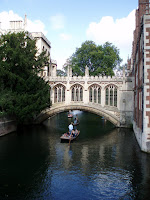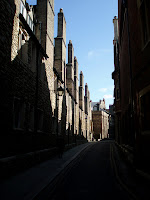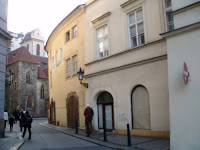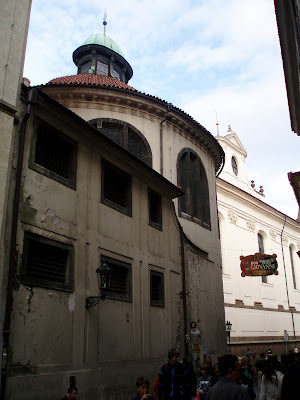I finally found Rudolf's art collection over the weekend. On Saturday, I realized that the building on Hradcanske Namesti (Castle Square) that I'd been admiring for the
trompe l'oeil work on its facade was in fact yet another branch of the Narodni Galerie (National Gallery). And, of course, it's the one that houses the Mannerist and Baroque painting. So, I felt like a bit of an idiot, having visited every *other* branch of the National Gallery before actually finding the one I'd wanted to go to in the first place.

The National Gallery and, indeed, the city of Prague, play up the Rudolfine art aspect in the advertising. This raises interesting questions about how the "outsider" Habsburgs, villains in the national imagination for so long, are viewed in 21st-century Czech lands. I'll muse on those questions in another posting, though. Rudolf II (reigned ca. 1576-1612) was once ridiculed as the most incompetent ruler of his day. He had a penchant for natural philosophy (in his case, this involved a heady mixture of alchemy, astronomy , and astrology) and for collecting painters and paintings, wonders and curiosities, and for (horror of horrors), being a painter himself -- all at the expense of his governmental duties (or so the story goes). Lately, though, his legacy has become a big thing in Prague. There was a revival in interest in his artistic tastes during the 1980s, a revival that seems to have been triggered by one book in particular:
The School of Prague, by Princeton art historian Thomas DaCosta Kaufmann. A major conference,
Rudolf II and Prague, held in the late '90s, completed the recasting of his image from latter-day Nero to reincarnation of that other national hero for Bohemians, Charles IV (he of Charles Bridge fame).

So, with all the hype, I was a little disappointed in the contents of this "Rudolfine" section of the National Gallery. There was a great selection of later 17th-century paintings by the painter Karel Skreta, but there were but a few "Rudolfine paintings" -- works by people like Bartholomaus Spranger, Hans von Aachen, Arcimboldo, and Josef Heintz the Elder. I had a feeling this would be the case; as I've mentioned
ad nauseam, a great deal of it is in Sweden. Rudolf's nephew, Leopold Wilhelm, also a great collector, took what remained with him, and it subsequently went with a lot of Habsburg collections to the Kunsthistorisches Museum in Vienna.

What remains in Prague seems to be the odd altarpiece and portrait that was hidden in private collections or in churches, or that didn't appeal to subsequent generations of art-lovers (or looters).
The highlight was undoubtedly Spranger's
Epitaph of the Goldsmith Wilhelm Muller, a piece he painted for his father-in-law. You can see it here:

It's much larger than I expected -- the
Triumph of Wisdom, a kind of secular companion-piece to the
Epitaph that lives in Vienna, is smaller, if memory serves me right.

Lazy as I am, I always take the streetcar uphill to Prague castle, and enjoy the walk down-hill afterwards. There are several paths down, and I haven't yet taken all of them. The one path I find myself taking over and over is essentially a set of stairs heading straight down the hill to the Wallenstein Garden, which I mentioned in previous posts. This path is particularly nice because it looks down upon an idyllic patch of green in the middle of the city. I think this is where all the various gardens of all the various former estates meet up, and for whatever reason, the areas remained as a garden. You can see a few vineyards on the hill, and then just green...

I resumed my trek downhill and spent the afternoon wandering through Mala Strana (the Lesser Quarter, or Kleinseite). This is the neighbourhood right at the foot of Castle Hill, and it's crammed full of churches and palaces. This was where the courtiers lived, so historically it was largely German and Italian, with the odd Spaniard wandering around (in the 16th century at least). I turned a corner into a small courtyard and this building, with its lovely
sgraffito facade, caught my eye.

Turning around, I saw a beautiful crucifix. It turns out I'd stumbled across the house where Aegidius Sadeler, one of Europe's most famous engravers ca. 1580-1620, had lived when he was employed by Rudolf II.
On Sunday morning, I broke with habit, running uphill to the Castle, in order to dodge a streetcar inspector. I'm pretty sure I paid enough (26 koruny, about 1.50) for the metro-tram combination, but I wasn't entirely sure -- the payment scale isn't exactly clear. In Prague, as in Vienna and elsewhere, public transport payment operates under an honour system, bolstered by the activities of some truly fearsome inspectors who randomly hop on streetcars or wait for you menacingly at the top of the subway escalators. In any case, on Sunday, I heard the inspector making her way from the back of the streetcar to the middle, where I was. I wasn't sure if I was supposed to have an extra ticket for the streetcar, or whether my metro ticket (valid for 75 minutes) was also valid on the streetcar. My hands got sweaty when I heard her giving a very hard time to three tourist girls behind me (who had purchased tickets the day before, and never validated them, or something similarly unforgivable). Just as she finished up with them, the streetcar pulled up to a stop and I, trying to look casual, stepped off. Luckily, she did not follow, and I breathed a sigh of relief as the streetcar pulled away.

I ran up the hill to Mass at St Vitus Cathedral, having seen advertised a performance of a Renaissance mass, and not wanting to be late. When I arrived, I realized that the poster must have referred to the previous Sunday, because it was just a regular old organ+not-too-spectacular soloist combination. There was, however, lots of incense and bell-ringing. After the Credo, I thought I'd leave -- it was largely in Czech and I saw a few other people heading for the doors. Leaving wasn't as easy as I'd hoped, though... the doors were all locked! I realize this must be to keep out the masses of noisy tourists who traipse blithely through the cathedral at all other times of the week, ignoring the sign that instructs "SILENTIUM," and all but clambering over the wrought iron railings to photograph tombstones and altarpieces. In any case, if they were locked
out, that meant we were locked
in. I shivered back to my pew (it was cold!) and settled in for the long haul.

On the way back towards my usual pathway, I passed the Lobkowicz Palace. The name is familiar, of course. Any self-respecting classical music historian knows of the Lobkowicz family and their palace in Vienna the 18th century. There, they maintained an orchestra which they "lent" to Beethoven for his fourth and fifth symphonies. One of the Lobkovice even started a kind of stipend for Beethoven, to ensure he could keep composing what he liked without having to bother with a church job or something potentially constricting.
Upon entering, I found that they've opened up a museum there, one dedicated to the Lobkowicz family history. Turns out they still exist! They had a turbulent 20th-century -- apparently they were one of the richest families in central Europe when the Austro-Hungarian Empire fell in 1918. Like most residents of the region, they did fine in the fledgling Czechoslovak state. When the Nazis established the protectorate of Bohemia and Moravia, though, they seized the Lobkowicz properties --- numbering some 100 castles, and innumerable paintings. In 1945, the family got the properties back, only to lose them again in 1948 when the Communists took over. They emigrated to America with very little (although, I suppose, very little for a Lobkowicz is probably a lot for anyone else). Their art collections languished and their palaces deteriorated. The Communists were simply in no position to maintain these vast properties or to conserve the artwork.
After the Velvet Revolution in 1989, the Lobkowicz family, now living in Boston, started a 12-year legal effort to reclaim some of their property. They eventually got a large part of it back, including the Lobkowicz Palace in Prague. Part of it was not returned, and part of it they returned to the state because its condition, or the condition of the surrounding area, was just too bad for them to be able to renovate on their own.

After the anti-climax of the National Gallery's Mannerist collection, the Lobkowicz proved to be an unexpected high point. The paintings were incredible -- many from the period I'm studying, as well -- and included a Velasquez, a Cranach, and countless other gems. The portraits of the family, going all the way back to the early 16th century, lined room after room, and were fascinating. AND, they were by some of the Rudolfine painters that I'd been looking for. Many of these paintings have rarely been reproduced, if at all, as they weren't given much exposure under the Communists. I was very surprised (and delighted) to see Pieter Brueghel's
Haymakers (pictured here) on display...
One thing I loved - I wish they'd had a postcard at least for me to pick up on the way out -- was the "Dog Room." The Lobkowicze have been dog lovers since the 16th century, and have commissioned actual portraits of their beloved beasties over the centuries. Those paintings were actually my favourites in the museum... There was also an 18th-century "Bird Room," filled with odd little pictures, artfully done, of birds in watercolour and with actual bird-feathers pasted on for the plumage.
Then, as if things couldn't get better, they had a "Family Music Room." In that one little room, there were the original performing parts for Beethoven's 4th and 5th symphonies, and the Op. 18 quartets. There was also the performing score for Mozart's re-orchestrated version of Handel's
Messiah, complete with Mozart's corrections. Interesting for my own work were several bound books of lute music from the 16th-century, with bindings that match a set of bindings that I'm trying to learn more about... I read that they have just opened up their family library to scholars. It's about 25 km north of Prague, and contains the rest of their sizeable music collection -- not catalogued anywhere except in the library itself, though. I'm hoping to hop on a train out there sometime before I go back home. It may prove to be a goldmine. Which is why I'd like to speak to a Lobkowicz, please...

It is proving rather hard to get in touch with the administration of the library, though. Modern-day Lobkowiczes, it seems, have capitalized on the "destination wedding" market, and so their website (yes, they have a website: http://www.lobkowicz.eu) is dedicated primarily to advertising the rent-ability of their palaces for weddings. To a lesser degree, they seem interested in promoting their beer. Their specialty is the "Baron" brew. Well, it's not Beethoven, I guess, but it's beer... How times have changed!


 One of the first things I did in Cambridge was to buy a bicycle. 35 pounds or so got me a slightly battered Raleigh bike, purple with a tattered wicker basket. 5 pounds at the local Tesco got me a set of lights, and a little bell whose faint ding!—more an ‘um, excuse me’ than a ‘get out of my way’—betrayed its owner’s thrift. Undeterred by the twigs that had flown off the mouldering basket as I pedalled happily from Madingley Road to the center of town (an unwitting Hansel-and-Gretel trail of damp wood, pointing my way back home), I loaded it up with frozen Indian appetizers and Grown-in-the-UK (complete with a picture of the farmer) apples and lettuce from the local Sainsbury’s.
One of the first things I did in Cambridge was to buy a bicycle. 35 pounds or so got me a slightly battered Raleigh bike, purple with a tattered wicker basket. 5 pounds at the local Tesco got me a set of lights, and a little bell whose faint ding!—more an ‘um, excuse me’ than a ‘get out of my way’—betrayed its owner’s thrift. Undeterred by the twigs that had flown off the mouldering basket as I pedalled happily from Madingley Road to the center of town (an unwitting Hansel-and-Gretel trail of damp wood, pointing my way back home), I loaded it up with frozen Indian appetizers and Grown-in-the-UK (complete with a picture of the farmer) apples and lettuce from the local Sainsbury’s.

















































